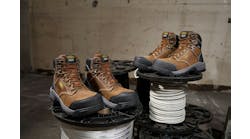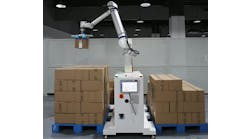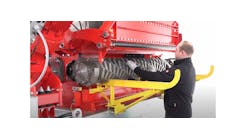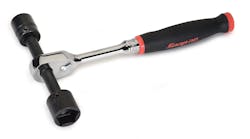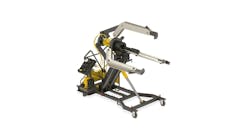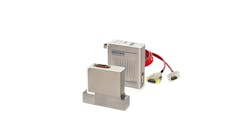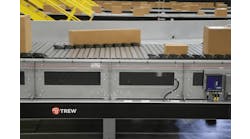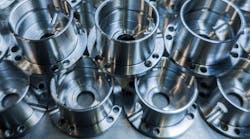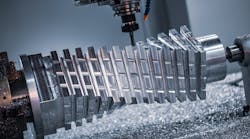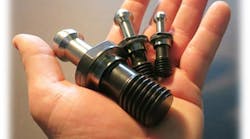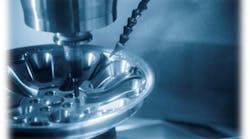More than most industries, aerospace component manufacturing machines have a lot of exotic alloys and hard metals like titanium. A byproduct of using these materials is that more pressure is put on the machines, spindles, and retention knobs. The end result is that the tools must be changed out more frequently as they dull or break. The cost of tool replacement, not to mention the loss of production time due to frequent changeover, can escalate costs as well—often to dizzying levels.
Recently, Flying S, Inc. (Palestine, IL), a high-quality parts aerospace/aviation industry-focused engineering company since 2001, continued its expansion to more palletized five-axis machining center technology to handle the high-volume production precision machining of complex, tight-tolerance parts out of titanium, stainless steel, and other difficult to machine materials.
Notably, as the five-axis parts they made for unmanned military and civilian aircraft, along with spacecraft, became more complicated, it became clear that greater machine capability was needed to achieve reliable, unattended operation.
According to Manufacturing Engineer Peter Bowman, “Many of our space flight fittings require tight-tolerance features. Our lack of reliable positional accuracy and repeatability due to thermal growth, machine positioning or other variables, really took a toll on our efforts to consistently make a good first part, and subsequent parts after that.”
With new five-axis CNC machining centers in place, including state-of-the-art models from Matsuura USA (St. Paul, MN), and Brother Industries, Ltd. (Nagoya, Japan), significantly higher torque and drawbar pressure was being exerted on their standard, low-cost retention knobs causing issues with the interface between the tool holder and spindle. Consistently, standard retention knobs were coming loose as dimpling/grooving wear issues repeatedly appeared on the face of the knobs—thus requiring replacement on a regular basis.
Whereas machining is about eliminating variables, Flying S actively sought out a solution to resolve its retention knob issues. During a visit to IMTS (International Manufacturing Technology Show, Chicago, IL), Bowman witnessed an expanding taper demonstration by JM Performance Products, Inc. (JMPP: Fairport Harbor, OH), which featured their patented High Torque retention knobs. Uniquely, the knobs were designed and engineered to eliminate the tool holder expansion responsible for costly and ongoing CNC milling and boring issues.
A leading manufacturing innovator of CNC mill spindle optimization products since 2009, JMPP’s retention knobs feature a relief beneath the precision pilot that forces the threads of the knob deeper into the threaded bore of the tool holder—where a thicker cross-section of material resists the expansion and deformation.
With their multi-axis and unattended operations expansion commitment in full force, Flying S set out to standardize their entire line of CNC machines with JMPP’s retention knobs, in order to overcome catastrophic failure as a result of metal fatigue and other high load force-related issues associated with difficult to machine materials and long tooling.
Multi-Axis/Multi-Issue Variables:
Today’s CNC mills, like Flying S’s multi-axis machining centers, are designed to operate with greater drawbar pressure, faster tool changes, higher feed rates, and greater depths of cuts, which places more demand on retention knobs in V-Flange tooling than ever before. Flying S was able to address the following key issues via JMPP’s retention knobs.
Titanium Challenge: Superalloys/exotic materials such as stainless steel, aluminum, and titanium are on the rise for component manufacturing in vital growth industries such as aerospace, medical, and automotive.
Considering that high speeds typically in excess of 20,000 RPMs are often required, a unique set of production machining challenges ensue. Notably, vibration and chatter can occur at these rates of speed, leading to poor surface finishes that require secondary bench operations or result in critical damage to expensive workpieces.
Stability is an essential factor for improving milling performance on demanding materials like titanium as the entire machining process has to be considered. Any one element could impede the overall process’s effectiveness as the tool, tool holder, spindle, column, ways, table, fixturing, and workpiece are all part of the interconnected ‘machining circle’ that requires stability to achieve optimal results.
Retention knobs are the critical connection between your machine tool and the tool holder, and they are the only thing holding a steep taper tool holder in the machine’s spindle. However, oftentimes retention knobs are overlooked by many shops, with a greater focus placed on having a high-quality machine tool, top-of-the-line tool holders, and the latest high-performance carbide tooling.
Then, ironically, they will break the loop by using economy retention knobs.
Notably, they go through thousands of tool changes which means they are subjected to very high pull forces from the spindle’s drawbar. Excessive torque tends to swell the metal around the retention knob, distorting the tool holder and creating a less-than-perfect fit between it and the spindle taper. Additionally, tool holder expansion caused by standard retention knob installation can reduce the tool holder-to-spindle contact by 70% or more. It’s no surprise that many machine tool builders specify the use of high-quality retention knobs for the best performance.
High Torque Solution:
Yet, just having an expensive retention knob does not mean better performance. JMPP redesigned the standard retention knob into its patented High Torque retention knob which uses the lowest available threads in the tool holder. The pilot portion beneath the knob flange above the threads stabilizes the knob in the tool holder. The High Torque design includes a precision ground pilot, that ensures the perfect alignment of the knob in the holder during installation.
JMPP also manufactures all 30 and 40 taper retention knobs, including the patented High Torque knobs, from AISI 9310H material—offering 40% more tensile strength, instead of the traditional 8620H material.
TSC Challenge:
Deep-pocket drilling of exotic materials, like titanium, requires more coolant that acts like a high-pressure garden hose. This Through-Spindle Coolant (TSC) runs through a hole in the knob, which allows the coolant to run through the tool to the tip of the drill, thus helping to achieve heavier cuts, higher feed rates, deeper holes, and better surface finishes.
It's often used for drilling into tougher materials like the ones used by Flying S in their aerospace applications. It also allows for better chip evacuation by forcing the chips out of the hole, thus improving process reliability.
As one can imagine, putting a hole in the center of the knob where the coolant runs through can cause major issues when using economy retention knobs since they are made from weaker materials. Often times TSC retention knobs are where failures occur because of this design characteristic.
High Torque Solution:
JMPP’s longer length and shorter threads mean less torque value and more leverage on the holder for high-pressure TSC with less fretting on the holder or vibration. The size of the coolant holes has also been sized to increase the cross-sectional strength of the knob.
Bowman noted that “We use JMPP’s knobs as standard for both TSC and non-TSC applications across the board because there is no need to swap them out when using TSC. It’s a safety measure for us. We would rather standardize so that ALL retention knobs are TSC capable, thus reducing the chance of trying to run high-pressure coolant on a non-TSC knob, thus flooding our spindles. What we found is that the knobs handle the force on the holder exceptionally well with no leaks at 1K psi and no signs of excessive wear.”
Aerospace Expansion/High-Torque Standardization
With the expansion of more state-of-the-art multi-axis machining centers, Flying S has implemented a standardization plan to exclusively use JMPP’s retention knobs. To date, they have roughly 2,000+ retention knobs in their shop’s operation including and featuring the following tool tapers:
CAT 30: Flying S currently uses BT30 TSC High Strength knobs in their Brother M140 and M200 machines. These are small spindle, high production 5-axis machines, typically with longer tooling requirements and robotically loaded, so the retention knobs work extremely hard, thus far with zero issues reported. See the picture of the 3 “Brothers” below.
CAT 40: The majority of Flying S’s tooling is CAT40, so it is midsized. They use these retention knobs in their 5-axis Matsuura and Haas products. Some of these machines are the Matsuura MAM72-70v 18 pallet, MX-850 4 pallet, MX-520 4 pallet, and MAM72-25v 40 pallet. Haas would be UMC-750 5 axis and numerous other vertical machines. According to Bowman, “To date, we’ve had no issues, as far as I’m concerned, and will only use JMPP knobs going forward.”
CAT 50: Flying S just purchased their first CAT50 machine, the Matsuura MAM72-100H−the largest 5-axis that Matsuura makes. The MAM72-100H is a beast, boasting a 6 pallet system, 245 tool magazine, and horizontal 5-axis machining center with 1,000 millimeters of pallet swing.
“We will essentially be able to machine a 2.5-square-foot cube of stainless steel if we wanted to, which is wild. This machine will also use JMPP’s knobs exclusively.”
Aerospace/High-Torque Conclusion:
Machining complex parts are common in the aerospace and energy industries, with more companies investing in multi-axis machining centers that can match the demanding production challenges they face.
As Flying S grows, they continue to invest in more advanced machines. As a result, they continue to see the value in having the right tools to protect and get the most out of those machines.
By implementing over 2,000 of JMPP’s High Torque retention knobs, every tool on Flying S’s machines works better and faster to make their demanding projects more competitive, reduce machine downtime, extend tool life, and increase profit margins.
According to Bowman, “We were finding ourselves replacing the older $11 knobs on a regular basis. However, I have never replaced a single JMPP knob! Our standardization investment is great and I think it will last.”
Flying S has recently implemented an annual preventative maintenance plan for all of their machines that use JMPPs’ hydraulic Clamp Force Gage Fixture to regularly check the clamping/pulling force of the drawbar. Drawbars are a high-wear item in CNC machines and are often overlooked as equipment ages.
As part of this program, they also use JMPP’s advanced Spindle Cleaner Kit which is designed to clean CAT and BT spindles in 30, 40 or 50 taper sizes.
Bowman also noted, “We also rented their Taper Shank Test Fixture that we saw at the IMTS show to prove to ourselves, and management, that we needed JMPP products. The test was pretty shocking and very convincing. We had no idea how much our “economy” retention knobs were costing us!”
